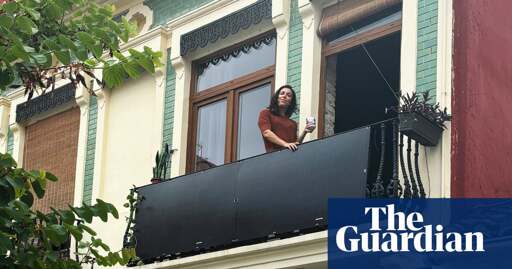My North-East facing balcony doesn’t get enough sun light. But it’s an interesting idea.
Isn’t wind energy better on balconies?
Hmm no,
- first oft all: noise. Wind turbines have moving parts, that attached to a building or even worse attached to a balcony creates noise in the whole building. Imagine the rattling of 5-6 ~10 year old, bad maintained, wind turbines.
- Second: the energy output is rather low. A 1,2KW turbine is about 1.2m/3.9feet big. That’s in spherical, cause it has to be able to rotate by wind direction.
- Third: balconies are preferred to not have wind, but sun.
- And last but not least: blades. Every windturbine form factor has (fast) moving blades. If it’s reachable someone is going to stick a finger in it.
If you’re living more suburban and have a windy detached place to setup a small windturbine that’s an option. On the garage or shed for example.
Sadly really small wind turbines are really ineffective and not worth the investment until you have a really windy balcony. If you only have a few square meters solar is the only choice.
But I’d still love to have a small windmill in my garden.
If everyone puts wind turbines on the balconies they might end up blowing the building over
I’m sure this is a good thing, but considering the vast majority of Germans haven’t figured out screens on windows I’m not sure the appeal to authority in the title has the desired effect.
What screens are you talking about?
We have fly screens in our windows. Windows which can be tilted btw.
You also have the best shutters ever.
Like fly screens?
Becausr in that case I don’t get it.
There is something in it - they are making solar panels with chemicals that makes energy trans
We even tried to make trains trans once
It’s going to be hard to justify production costs, but in places that subsidize it: it makes perfect sense to scale up solar wherever possible.
Hard to justify costs? The article quotes 6 years of amortization. I know numbers around 8-10 years in Germany.
Show me any consumer investment, that gives such a good ROI.
8-10 years is a fully fledged pv system. The small balcony panels pay themselves after about 5 years, longer if you add a battery.
The actual problem are electricity prices rising higher and that shortens to time to reach the equilibrium between the investetment
That’s 4’ 11" - I had no idea Germans were so short.
I wonder why only those people have balcony solar. Why aren’t other Germans interested?
This is great for people who live in the middling latitudes.
The relentless march of sustainable cosplay continues. A million Germans clinging to plasticky solar trinkets like rosary beads against energy insecurity—how very on-brand for a nation that dismantled nuclear plants to cozy up with Putin’s pipelines. Nothing screams “green revolution” like propping up coal while bureaucrats hyperventilate over balcony wattage permits.
But sure, let’s pretend these glorified battery chargers absolve collective guilt. Social media’s latest performative ritual—slap a panel on your railing, flood Instagram with hashtags, ignore the 14-month waiting list for certified installers. Peak late-stage decarbonization theater: all aesthetics, no grid.
At least it’s honest. We’ve stopped pretending policy can fix anything. Why demand competent governance when you can DIY your dystopia?
Are you under the impression that the people buying solar for themselves are against sustainable energy solutions on a state level?
“100 million smokers can’t be wrong!”
Home solar indicates a massive management failure of public utilities. If it is more cost effective and more pleasant to generate your own electricity without any economies of scale, something is very wrong.
Source: I live in California where the “public” utility is an absolute disaster that charges $.60-$.70/kW/hr so anybody who can afford the upfront cost of solar has done so.
God, I love living in a nuclear plant evacuation zone
Microgeneration makes way more sense to me. If you generate the power where it is used without pollution, we should. The unfortunate piece is we have to many landlords who’s interest are too divorced from their tenets to put up more microgeneration
Grids work on economies of scale. The bigger the better. Ask anyone who lives on an isolated island for their power bill. That’s why it was such a big deal when the Baltics switched from the Russian grid to the EU one.
Bigger grid = more intertia&redundancy = less likelihood of failure, more options, lower costs.
Electricity isn’t like chicken eggs. Transporting it is for all intents and purposes free. The network is expensive, but whether your house is pulling 1 A or 5 A is a non-difference to your utility. So to think local generation is “better” is a complete fallacy. Unless your house is fully disconnected from the network (not “net zero”, disconnected) then it’s not helping to generate power locally. Like someone else said, it’s actually way more expensive per kWh than grid-scale solar.
Now this would all be a “you” problem, except the big problem with microgeneration is that current tech is “dumb”. It’s either pushing power on the network, or sometimes tripping if the voltage goes above 250V or so. Which actually happens in rich neighborhoods on very sunny days where everyone is pushing power.
What this means for the operators is that on very sunny days, they cannot do anything but account for the extra residential solar power. Which might mean they have to very quickly spin up or down alternative power generators which were not meant for this. Or they might be dealing with complex issues with current flowing the other way than designed and large voltage fluctuations on specific parts of the network that don’t have the necessary infrastructure to “dump” that extra solar somewhere else.The end result is that, counter-intuitively, microgeneration is one of the many failures of the neoliberal electricity market. It’s more expensive and more disruptive for society than if those solar cells had been put to use in grid-scale solar production. They only end up where they are through political mismanagement and misaligned incentives (e.g. net metering which does not account for negative externalities).
I am sorry, but your ideas about how these things work are ignoring a lot of issues.
First of all you have significant losses in the distribution grid. This is minimized the higher your voltage is, which is why longer range grids run on 110 kV and more. Then you have an intermediate level, typically 20 kV. Finally you get your local distribution with 220/230V. Also “current flowing the other way” does not exist in AC, because the “direction” changes 50x per second.
Then you only have a limited transportation capacity, so moving a lot of electricity from a central plant of course costs a lot of investment and maintenance. The idea that “Transporting it is for all intents and purposes free” is completely out of touch with the reality of the electrical grid.
But it gets worse. The more producers and consumers you have, the more you will need to balance fluctuations in production and consumption. This is why traditional grids were built around having a high baseload, with incentivizing high demand industries to connect, stabilizing demand. For renewables this is completely different, because renewabls will fluctuate. So the more energy you run through the centralized grid, the more short and medium term storages you will need to provide and the more investment and running costs you will have.
You mention this with there being too much production on the local grid and then in another place also needing to react to this. This is not a problem exclusive to local grids. It is a problem for any level of the grid with integrating renewables. Note how the article also mentions the limit of 800W without requiring a permit.
Finally in the long term we need to make the demand more flexible to production. So if the sun shines and the wind blows, household appliances should run, the fridge should cool a bit stronger, and the water heater heats up for the evening shower… Having a responsive demand with millions of agents can easily lead to overshooting, so that the demand spikes up far beyond supply, because every consumer reacts at the same time and it doesn’t temper out.
This problem is much smaller, if every household can directly see their own production and consumption and already limit how much excess goes into, or is demanded.
So microgeneration is part of the solution and not a problem like you make it out to be.
If you generate the power where it is used without pollution, we should.
Generators take space, require maintenance, and have a certain optimal capacity that isn’t necessarily hit on a given roof.
For wind energy in particular, the bigger the turbine, the more yield per $ spent. If you go out to Corpus Christi you’ll see these enormous turbines - $10M to $50M / ea - that generate on the order of $24 to $75 per MWh, or $.024-.075/kWh. Home wind/solar don’t get anywhere close to that.
Prime placement of units, distribution across a wide area, and a degree of storage capacity means you’re going to get better and more consistent yield.
But people will always be interested in generating their own, just like we don’t use communal bath houses, or community heating, or unfortunately mass transit. Yes, group services can be a lot more efficient and more reliable but they’re also out of your control and become an ongoing cost
Who is we? Lots of places do communal bath houses. Japan has an entire industry around it. Mass transit is also highly prevalent.
Yes there will always be some level of individual desire to do things or need in some cases but communal projects are useful and common I don’t get the dismissal of that for energy creation something we long ago figured out was better to be done at scale and distributed after.
This is neoliberalism and treating it like it’s the only way to exist. It’s a failure of consideration or imagination. Either way your take is not right for that.
just like we don’t use communal bath houses, or community heating, or unfortunately mass transit
Spas and apartments and buses/trains do absolutely exist. Only the former is considered “luxury” in the US, though.
Yes, group services can be a lot more efficient and more reliable but they’re also out of your control
Wasn’t Solar City’s whole gambit to effectively buy everyone’s roofs and lease them back for a fraction of their real market value?
I don’t think you escape “Own nothing and be happy” just by throwing up a few hundred watts of solar on an extension cord.
welcome to the land of windmills
These microinverters aren’t made of fairy dust. Doing this stuff at utility scale uses a lot less nasty minerals and chemicals.
Transformers, power lines, roads, trucks, and maintenance teams to move from large scale plants to houses also doesn’t grow on trees, but if maintenance in remote places doesn’t happen it can burn a lot of them.
Sometimes large scale plants make sense, but as the back up too microgeneration where the costs of infrastructure to move from unpopulated to populus areas make sense.
I am also a fan of less inverted power in microgeneration though. More and more of power usage is DC anyways. The need to convert to AC as much IMHO, but that is my far more radical take
Makes sense mathematically or you think makes sense?
Both.
The reduction of infrastructure and leveraging existing buildings without reducing their existing utility vs converting a new space to be a dedicated power plant plus the infrastructure to move power from less populus (normal case because the cost of populus land is high due to demand) to more populus space.
I also idealogically support it because it makes more controllable by people and less controlled by an outside entity (a corporation/state).
I live in an area where there is a monopoly of power supply by one of the worse polluters in American history, in a small area within a county there’s an existing co-op power company that was basically grandfathered in because it’s been in existence for so long while no other competitors are allowed in the area.
That co-op when I lived in the area was about half the cost of the monopoly company, a relative gets actually paid to be a member because they received their fathers account when he passed away and extra funds are distributed among all the members based on how long they’ve been with them (a little weird, but at least better than shareholders getting the profit).
You are absolutely right that the electric companies as a whole have failed, they’ve been allowed to amass too much influence and coverage while squashing any kind of competition. Why electrical needs aren’t considered a national resource is mind baffling to me. Our country and citizens way of life would literally grind to a halt without it.
The rent seekers making everything worse again
My dumb ass: “Is it just 1.5m Germans, or other heights too?”
1.5m Germans are 150cm people !
M in million should always be capitalised for this reason.
1.5M Germans vs 1.5m Germans
Megagermans vs milligermans
Megagermans just sound evil.
And milligermans, well there’s a vaccine against that I think.
This is really nice! This is the future!
I’d love to know how much they produce, especially during the winter/monthly.
That kind of depends on what you’re building. Standard is currently 800W (2 standard solar panels). Older models use 600W, other models are using 2000W and limit it to 800W. That doesn’t make much sense, but skirts our local regulations that limits them to 800W, but of course generates more energy.
It then also depends on where you live. Can you point it to the sun? Do you live in sunny Spain or in northern Norway? In Germany a 800W system can produce 800-1200kWh per year. Our average electricity price is at 0.35€, so you’ll save 280€-420€ a year. And those systems are dirt cheap, there are deals out there where you can get one for 200€. That is quite a good ROI for something that you can install in an hour.
Yeah I get all that, but what if I need heating in the winter and have very low consumption in the summer? That is why I’m searching for real world numbers. If you give me some for a specific place then I can at least have a ballpark number if what I might get where I live.
OTOH as you say, they start to be so cheap it’s almost impossible to go wrong…
That won’t really work as that is the worst scenario for solar. I can give you real world data from southern germany. I don’t have balcony solar, but a 13,4kWp solar system on my roof. Here is the data from this year:


As you can see, days are getting longer in Feb, generation is going up. To get a rough estimate, take my data and divide it by 16,75. That won’t give you a lot of heating, esp. with a normal space heater. Even if you had a scenario, where your 800W solar system would produce 800W in the winter, your space heater will suck 2000W. Take a look at its power cord, you’ll see how much it uses.
So yeah, 800W is not much, but will cover your running appliances like your fridge, freezer, router or computer on sunny days.
Hey thank you! I’m definitely saving this off for my future calculations!
You’re totally correct about the rest, and I’m now able to roughly see if I should buy a 800 system or two, or theee… Electric hookups included in the calculation of course.
Be careful there - you’re pushing electricity in your grid and there is a reason why only one system is permitted in Germany. Don’t hook up two or three without talking with an expert.
In the Northern hemisphere, in Winter the Sun is at a low angle, so vertically oriented panels might produce more. As an example, I have a sunroom and at Winter’s Solstice the sunlight reaches about 3-4 meters into the room. At Summer’s Solstice there is no direct sunlight in the room, as the Sun is overhead.
couple of things to note:
- Not every balcony is southern facing
- Most older European homes don’t have A/C yet, so electrical costs are more during the winter months (that trend will change though I imagine)
- I think the numbers @Valmond@lemmy.world was asking about involved power output, that of course depends on the size of your array, daily/monthly/yearly differences in weather, and all sorts of little nuances that’s hard to say without averaging out years worth of data.
Wait that’s a thing?
Holy shit that a thing!? That’s awesome!!
In b4 nimbys complain it’s an eyesore despite most people never looking up
Usually not uglier than the balcony itself.
This article is more than 1 month old
Oh no! Quick! To the incinerator!












